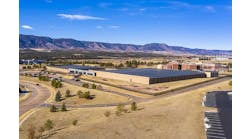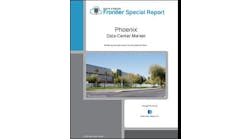Vertiv Expands AI Infrastructure Arsenal with New Data Center Power, Cooling, and Deployment Solutions
As data centers race to meet the relentless demands of AI workloads, Vertiv is rolling out a new suite of solutions designed to tackle the sector’s thorniest challenges: power density, thermal management, speed of deployment, and operational complexity.
Last month, the company unveiled four new systems aimed squarely at the infrastructure bottlenecks posed by accelerated computing. The latest additions — a consolidated management platform, prefabricated modular infrastructure, a high-density rear door heat exchanger, and a powerful new DC rack power system — reflect the company’s strategy to deliver end-to-end solutions optimized for AI and high-performance computing (HPC).
“With these additions to our portfolio, Vertiv provides easier end-to-end systems integration, faster deployment, improved scalability, and greater power and cooling density to address critical digital infrastructure challenges related to accelerated computing,” said Scott Armul, executive vice president of global portfolio and business units at Vertiv.
Armul added, “Our comprehensive range of advanced power, cooling, management, and deployment solutions positions Vertiv to uniquely support customers as they build and scale AI-driven data centers.”
Unified Management for an AI-First Era
Leading the announcement is Vertiv Unify, a cloud-connected management platform offering real-time visibility, control, and analytics across critical power and thermal assets. Designed for environments ranging from individual assets to fully integrated campuses, Vertiv Unify emphasizes scalability and plug-and-play simplicity.
The platform supports enhanced energy reporting and coordination across Vertiv’s full portfolio of critical infrastructure — a nod to Vertiv’s position as the only major vendor offering a complete suite spanning both the power train and thermal chain.
As AI environments become increasingly complex and interdependent, integrated management will be essential. Vertiv is betting that offering a single pane of glass across systems will resonate with operators struggling to optimize performance and energy use at unprecedented scale.
Rethinking Speed: Modular Overhead Deployment
In a market where every day of construction delay translates into lost revenue, Vertiv’s new SmartRun overhead infrastructure is designed to radically accelerate deployment timelines.
SmartRun combines high-density power busbars, liquid cooling piping, network infrastructure, and hot aisle containment into a single, prefabricated module.
Designed for rapid on-site installation — boasting deployment speeds of about 1 MW or more per day — SmartRun promises up to 85% faster deployment compared to traditional stick-built methods.
Vertiv backs the system with its global services organization, offering an end-to-end approach from design to ongoing support.
The speed-to-market edge, paired with SmartRun’s ability to handle increasing rack power densities, positions it as a powerful tool for operators scaling AI capacity.
Thermal Management for a New Heat Paradigm
On the cooling front, Vertiv introduced the CoolLoop RDHx, a chilled-water rear door heat exchanger capable of supporting loads up to 80kW per rack — a clear signal that AI-era thermal requirements are reshaping data center design.
CoolLoop RDHx is a compact, modular upgrade to Vertiv’s Liebert DCD rear door cooling line. It can operate as a standalone solution or be integrated with direct-to-chip liquid cooling, enabling operators to build room-neutral cooling architectures that align with emerging AI hardware profiles. An integrated fan module enables precise airflow control, improving both efficiency and performance.
Crucially, CoolLoop RDHx can be retrofitted into existing environments, providing a bridge for operators who need to transition to higher density without embarking on a full-scale rebuild.
High-Density DC Power: Ready for ORv3
Finally, Vertiv’s new PowerDirect Rack brings a high-density 50V DC power shelf to the table, purpose-built for Open Compute Project (OCP) ORv3 High Power Rack environments.
PowerDirect Rack doubles the power capacity per footprint compared to traditional AC UPS setups with separate rectification and distribution — scaling up to 132kW per rack.
Compatible with both AC and high-voltage DC inputs, the system offers real-time monitoring for enhanced operational visibility, another nod to the rising need for fine-grained infrastructure intelligence in AI-heavy environments.
In the context of the broader market shift toward distributed DC architectures and direct-to-chip server designs, PowerDirect Rack positions Vertiv as an enabler of next-generation, high-density compute.
Positioning for the AI Buildout
The timing of Vertiv’s announcements is no accident. As AI infrastructure spending continues to surge — with projections showing triple-digit megawatt campuses and soaring rack densities becoming the new normal — vendors who can solve multiple layers of the challenge simultaneously will command significant strategic advantage.
By combining modular deployment, unified management, advanced thermal solutions, and next-gen power delivery into a coordinated offering, Vertiv is making a clear play to cement its role at the center of the AI data center ecosystem.
The next wave of buildouts won’t just be faster or denser — they’ll be smarter, more integrated, and more operationally resilient. Vertiv’s latest moves suggest it intends to be a critical part of that future.
At Data Center Frontier, we talk the industry talk and walk the industry walk. In that spirit, DCF Staff members may occasionally use AI tools to assist with content. Elements of this article were created with help from OpenAI's GPT4.
Keep pace with the fast-moving world of data centers and cloud computing by connecting with Data Center Frontier on LinkedIn, following us on X/Twitter and Facebook, as well as on BlueSky, and signing up for our weekly newsletters using the form below.

Matt Vincent
A B2B technology journalist and editor with more than two decades of experience, Matt Vincent is Editor in Chief of Data Center Frontier.





